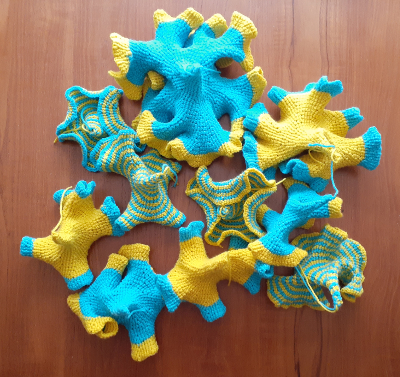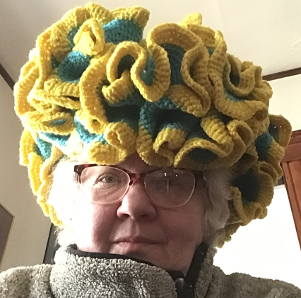Hyperbolic Surfaces for Ukraine

As you might know, my team started a project, Yulia’s Dream, in honor of Yulia Zdanovska, a young Ukrainian math talent killed in the war.
In this program, we will do what we are great at — help gifted youngsters pursue advanced math. To help the program, I started crocheting hyperbolic surfaces in the colors of the Ukrainian flag. These crochets are designed as gifts to encourage individual donors.
Fun trivia about these hyperbolic surfaces.
- Why are these surfaces so famous? These surfaces prove that Euclid’s fifth axiom is independent of the other four axioms. The fifth axiom (also known as the parallel postulate) says that if there is a line L and a point P outside of L, then there is exactly one line through P parallel to L. On these hyperbolic surfaces, the first four of Euclid’s axioms hold, while the fifth one doesn’t: if there is a line L and a point P outside of L on such a surface, then there are infinitely many lines through P parallel to L.
- But what is a line on a hyperbolic surface? A line segment connecting two points is defined as the shortest path between these points, known as a geodesic.
- How can such a surface be crocheted? I crocheted a tiny circle and continued in a spiral, making 6 stitches in each new row for every 5 stitches in the previous row. This means that each small piece of the crocheted surface is the same throughout the thingy, making these thingies hyperbolic surfaces of constant curvature.
- What is the constant curvature good for? Constant curvature makes it easy to find lines. You can just fold the thingy, and the resulting crease is a line.
- Is this thingy a hyperbolic plane? No. A cool theorem states that a hyperbolic plane can’t fit into a 3D space, so whatever someone crochets has to be finite. On second thought, anything someone crochets has to be finite anyway. But I digress. This shape can be viewed as a disc with a hole.
- The Ukrainian flag is half blue and half yellow, so why do the colors here seem so unevenly distributed? My goal was to use the same amount of blue and yellow yarn per thingy. I leave it as an exercise for the reader to calculate that regardless of how many rows of one color I crochet, to use the same amount of yarn in the second color, I need more than 3 and less than 4 rows of that color. Since I wanted the thingy to be symmetrical, sometimes I had 3, and other times, I had 4 rows of the second color. I also made 4 surfaces where I switched colors every row.
Overall, I crocheted 10 hyperbolic surfaces. If you are interested in donating to help Ukrainian students receive coaching from our program at MIT, the details will be announced on our website shortly.
Share:


